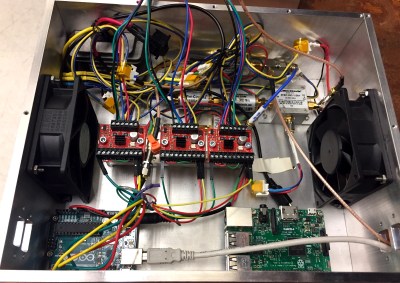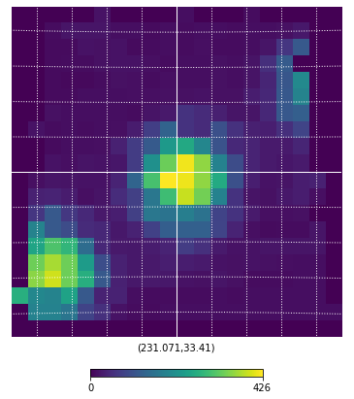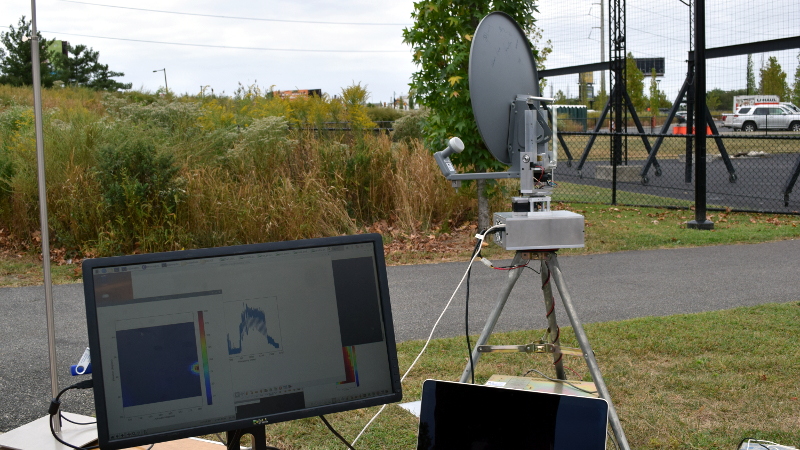You probably wouldn’t expect to see somebody making astronomical observations during a cloudy day in the center of a dense urban area, but that’s exactly what was happening at the recent 2019 Philadelphia Mini Maker Faire. Professor James Aguirre of the University of Pennsylvania was there demonstrating the particularly compact Mini Radio Telescope (MRT) project built around an old DirecTV satellite dish and a smattering of low-cost components, giving visitors a view of the sky in a way most had never seen before.
 Thanks to the project’s extensive online documentation, anyone with a spare satellite dish and a couple hundred dollars in support hardware can build their very own personal radio telescope that’s capable of observing objects in the sky no matter what the time of day or weather conditions are. Even if you’re not interested in peering into deep space from the comfort of your own home, the MRT offers a framework for building an automatic pan-and-tilt directional antenna platform that could be used for picking up signals from orbiting satellites.
Thanks to the project’s extensive online documentation, anyone with a spare satellite dish and a couple hundred dollars in support hardware can build their very own personal radio telescope that’s capable of observing objects in the sky no matter what the time of day or weather conditions are. Even if you’re not interested in peering into deep space from the comfort of your own home, the MRT offers a framework for building an automatic pan-and-tilt directional antenna platform that could be used for picking up signals from orbiting satellites.
With the slow collapse of satellite television in the United States these dishes are often free for the taking, and a fairly common sight on the sidewalk come garbage day. Perhaps there’s even one (or three) sitting on your own roof as you read this, waiting for a new lease on life in the Netflix Era.
Whether it’s to satisfy your own curiosity or because you want to follow in Professor Aguirre’s footsteps and use it as a tool for STEM outreach, projects like MRT make it easier than ever to build a functional DIY radio telescope.
Point and Shoot
The MRT, and really any radio telescope project like this, is essentially made up of two separate systems: one that provides the motorized aiming of the dish, and the receiver that actually captures the signals. Either system could work independently of the other, but when combined with the appropriate software “glue”, they allow the user to map the sky in radio frequencies.
Obviously, the electronics and mechanical components required to pan an antenna across the sky aren’t terribly complex. If you wanted to keep things really simple and were content with moving in a single axis, you could even do it with a “barn door” tracker. What’s really kicked off the recent explosion of DIY radio telescopes is the RTL-SDR project and the era of low-cost Software Defined Radios (SDRs) it’s inspired.
 Unsurprisingly, the MRT also uses an RTL-SDR receiver for processing signals from the Low-Noise Block (LNB) in the dish. Professor Aguirre says that since they are still using the stock DirecTV LNB, the telescope is fairly limited in what it can actually “see”. But it’s good enough to image the sun or pick up satellites in orbit, which is sufficient for the purposes of demonstrating the basic operating principles of a radio telescope.
Unsurprisingly, the MRT also uses an RTL-SDR receiver for processing signals from the Low-Noise Block (LNB) in the dish. Professor Aguirre says that since they are still using the stock DirecTV LNB, the telescope is fairly limited in what it can actually “see”. But it’s good enough to image the sun or pick up satellites in orbit, which is sufficient for the purposes of demonstrating the basic operating principles of a radio telescope.
To move the satellite dish, the MRT is using an Arduino connected to a trio of Big Easy Drivers from Sparkfun. These are in turn connected to the stepper motors in the antenna mount, which are sufficiently geared so they can move the dish around without the need for a counterweight. This makes it an excellent candidate for enclosure inside a dome, which would allow for all-weather observations.
Both the RTL-SDR receiver and the Arduino are connected to a Raspberry Pi, which runs the software for the telescope and provides the interface for the user. The MRT GitHub repository contains all of the various tools and programs created for the project, mostly written in Python, which should provide a useful reference even if you’re not interested in duplicating the telescope’s overall design.
Wandering Through the Sky
When we visited Professor Aguirre, he was attempting to use the MRT to find the Sun. You’d think that a simple enough task in the middle of the afternoon, but thanks to an unbroken layer of steel-gray clouds hanging low in the October sky, Sol was absolutely nowhere to be found with our meager human senses.

As the dish made its slow robotic pans across the sky, we spoke with the Professor about the telescope and the various revisions it went through over the years. Eventually the display lit up, showing a representation of an unusually strong signal, clearly the MRT was hearing something out there. After brief scrutiny, the Professor announced that we hadn’t found the sun; instead, the telescope most likely crossed paths with a geostationary satellite.
It was this raconteur style of discovery that kept visitors to the Mini Radio Telescope enthralled. Nobody expected this hacked together contraption of consumer-grade hardware to discover a new exoplanet or help solve some long-pondered mystery of the cosmos while sitting in a Philadelphia parking lot.
But it was more than capable of pointing out objects tens of thousands of kilometers away while our own eyes couldn’t even figure out where the Sun was. It reaffirmed in a very real way that something was out there, and students both young and old couldn’t help but be fascinated by it.















But you can hear Jupiter on a shirtwave radio at 18MHz, you will need an antenna but nothing extensive.
So the trick isn’t what you can assemble, but results. The field began as a byproduct of figuring out where interference came from, on tge shortwave band. In the thirties, even getting to 30MHz was pushing limits, though there was breakthrough by the end of the decade.
But a radio amateur is credited with the start of deliberate radio astronomy, later in the thirties.
So you could do.much with simple equioment, and as an amateur.
But, that was decades ago, the field has advanced so the simplest has long been accomplished. I suspect little new can be found with small equipment. Having your own radio telescope could be a neat thing, but likely woukd receive only simple things, long found by professionals in the field.
Remember, hams have put together much fancier systems, for moonbounce and other things. So they’d make their own large dishes, or scrounge surplus. They’d build equioment and use surplus. In 1972 QST ran an article about receiving some Apollo signals (I think one invooved was doing moonbounce too), using a lot of esoteric surplus. It didn’t come easy.
So just because there are cheap SDRs intended for tv reception, and tiny dishes, doesn’t mean much can be done. Doing things often requires a lot of understanding and effort, something tgat seems lacking when someone throws together some preassembled boards.
Michael
Your point is clearly addressed in the article.
however, as a starter project to dip a toe in the water and see if it light you up enough to devote time to said understanding and effort, using found/surplus modules to duplicate some old experiments seems like a legitimate way to get started.
Yes, the odds of discovering something entirely new (to humanity as a whole) are vanishingly small but the odds of an individual tinkerer learning something they didn’t know or developing a hands on intuitive understanding of something they knew only from a book are still excellent.
This. There are so many times when DIY leads people to do the impractical (especially when it comes to building instruments and tools), but the redeeming factor is almost always the learning.
It is a perfect project for someone like me, and my daughter who may be only 5, but has shown interest in astronomy, and physics.
I think this project is a great candidate for a school or classroom. Especially if kids have access to it during lunch breaks. It would encourage them to hunt for objects in the sky and try to work out what they might be, if they are moving etc
You know, doing things just for fun is a perfectly valid reason.
You should check out the SatNOGS project to see what can be done. You may be pleasantly surprised.
“Toy” plastic RC racing cars are nothing like real F1 racing cars but they are a lot of fun.
Anything that enriches my life seems like a good idea. I can’t afford the time, money, and skill for my own Formula 1 team. So other than as a spectator there is little I can do to participate.
I think a home-buiilt telescope, radio or optical, is a very enriching personal experience. Even if it has little impact on the world nor pushes modern science further along. There can be goals other than new discovery and writing papers. There has to be in order to sustain a passion for amateur astronomy.
Yeah. Love these thoughts
So we’re saying “The Arrival” with Charlie Sheen was more plausible than a dumb Hollywood idea when he made his own VLA out of people’s satellite dishes?
So good someone mentioned “The Arrival.” It certainly seems the case that it is plausible then. I had always wondered about your question. Great movie
So I have two of these dishes at the moment, for just this type of project. I’m assuming if I could get a third, my “field of vision” would be that much greater, right? Of course, I need to learn how to tie all three together.
I wonder if there are groups, similar to the lightning website group, that allow multiple dishes like these to be pooled together for mass viewing.
It’s worth mentioning the Society of Amateur Radio Astronomers in one of these pieces, http://www.radio-astronomy.org/ has tons of pointers for building your own equipment and such.
With a little coordination and “cloud” control, couldn’t you network tens of thousands of these across the planet to create a single giant radio telescope? Even with poor hardware, I think the distance and number of dishes could give decent resolution of certain objects, no?
In theory yes, but you need quite precise time stamping of each telescope’s samples such that the wave from one dish gets combined with the wave from (every) other dish. At shorter wavelengths where the sampling frequency can be much lower then you may get away with a gps clocked receiver. If the signals are out of sync it’s not a disaster, ‘all’ you need to do is keep shifting one of the signals one sample in time in either direction until you get a correlation between the two signals.
For a 1 MHz bandwidth signal sampled at 2 MHz, if your timing accuracy is good to a millisecond then you could have up to 4000 samples difference between the two signals. Many radio sources are a continuum though so you could reduce your sample rate to make the timing easier with the tradeoff you’d need to spend more time observing to achieve the same sensitivity.
This should be possible using GPS signals as a reference.
SDRs with GPS disciplined oscillators … that gets complex and fairly expensive quickly. Moreover the spatial resolution will depend on all antennae pointing exactly in the same direction at the same time.
That’s not true. There are very high quality yet still affordable GPS modules with timing capabilities out there. You may need some experience with digital design to timestamp the sampling (FPGAs ideally, but microcontrollers these days also have timing peripherals for real time sensing etc) but this is all quite accessible to hobbyists. Obvious nobody’s talking about plug and play.
I am thinking this wouldn’t have to be live.
Some large number of small-dish amateur astronomers could point all their dishes the same direction and then record the same chunk of time in a format that includes timestamps. These samples could the be assembled digitally later.
I had the exact same thought while reading this piece! I imagine the hardest part would be making sure all of the dishes are pointed at the target with enough precision to be able to stitch all the data together in a cohesive picture?
I’d think GPS timing would get you close enough but assuming all the dishes are internet connected having the server keep a master clock then syncing to that while adjusting for your ping time shouldn’t be too difficult?
“This makes it an excellent candidate for enclosure inside a dome, which would allow for all-weather observations.”
Why would the parabolic reflector need a dome? Rain would cause attenuation in the signal path but I doubt a dome would be of any help.
The dome can protect the dish from wind. Strong gusts can temporarily knock the antenna out of alignment, very strong gusts could damage the mounting system. The added benefit is it keeps the rain off so you don’t need to bother with any special waterproofing for the electrics.
A dome allows for thinner lighter dish and no need to waterproof electronics.
The big question is why an unbalanced setup would be good for a dome, when most, if not all, commercial domed antennas are balanced.
Thanks, I was considering just the rain and not the wind.
Would a metal dome be an issue over any wavelengths?
If the metal dome has holes (i.e. it is a mesh) it will let pass frequencies with a wavelenght one order of magnitude smaller that the size of the holes. But I guess that a metallic dome full of holes would be useless unless if covered with an isolant waterproof substance.
“Thanks to the project’s extensive online documentation,” . Ok I can find the schematic, and code for the pan-and-tilt part, but nothing, except for a couple of pictures, of the mechanical assembly. Am I just missing it or did they not include that part?
What is the software you’ve used?
layered internet tethered sooon satillite cable mobile and wifi. 200 mpbs uploads for live 8k videos for cable tv watching nfl games after the ai cpu is made for all screens on mobile deviuces laptops and desktop pcs and tv. next please.
just wondering if with that kit I could convert in audible signals the radio emissions coming from a pulsar or some universe element that triggers any special signal.
i think it is useful if i connect a cheap USB spectrum analyzer to the LNB to see the signal on pc dia mached software
I think this is the coolest thing EVER!
So, what if you’re already an amateur astronomer with a nice 8in refractor…
How cool would it be to sync your telescopes (optical and radio) onto the same object and listen to what you’re looking at?!